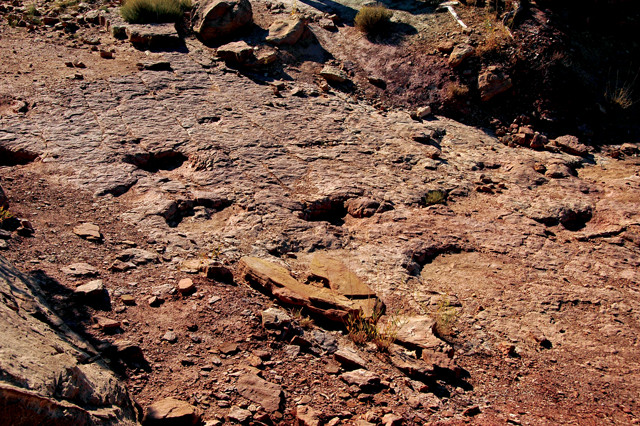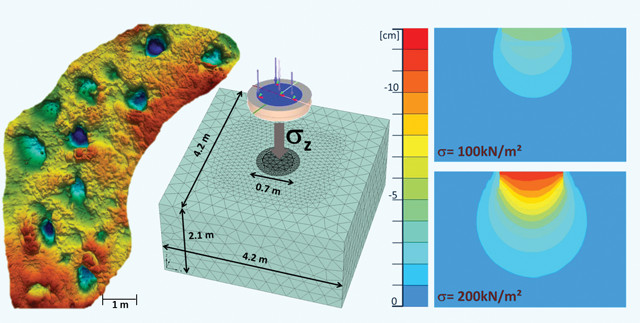
by David Moscato Wednesday, November 15, 2017

These footprints — in roughly 150-million-year-old sandstone at the Copper Ridge tracksite in eastern Utah — were made by a single sauropod, possibly a Diplodocus or Camarasaurus. Credit: James St. John, CC BY 2.0.
Body mass is a fundamental factor in determining how much food an animal requires, how it moves and grows, and what role it plays in its ecosystem. Measuring modern animals is often a straightforward matter of putting them on a scale, but it’s no easy feat for paleontologists interested in extinct creatures like dinosaurs, since many of these animals’ weighty parts — their organs, muscles and skin, for example — are long gone. Frequent claims of “the heaviest dinosaur of all time,” for example, as in the case of the recently named Patagotitan, are fraught with uncertainty. Recent research, however, is offering a novel approach to estimating dinosaur body masses by examining the footprints they left behind.
“Tracks are fascinating because they were made by a living animal,” says paleontologist Sashima Läbe, a fellow of the Andrea von Braun Foundation at the University of Bonn in Germany. And unlike fossil bones, footprints directly record the actions and physical dimensions of dinosaurs while they were still alive. In research presented in August at the annual meeting of the Society of Vertebrate Paleontology in Calgary, Läbe and her colleagues modeled soil mechanics to investigate how the largest land animals ever — the long-necked sauropod dinosaurs — would have crushed the sediment beneath their feet.
The team studied footprints, from both front and hind feet, made by a single sauropod in roughly 150-million-year-old sandstone at the Copper Ridge tracksite in Utah. Employing a technique called finite element analysis (FEA), Läbe and colleagues created virtual models of the soil that the dinosaur stepped in. This digital sediment could then be deformed by various loads to simulate the dinosaur’s feet and determine the weight needed to create the same soil deformation observed in the footprints. After accounting for how the animal’s weight likely would’ve been spread over its four limbs while walking, Läbe’s team could estimate the dinosaur’s total body mass at about 16 tons.
“Unfortunately, there isn’t a [fossil of the] trackmaker at the end of the trackway,” Läbe says, so the identity of the sauropod that made the tracks isn’t totally clear. But the team’s estimated mass is comparable to previous estimates for dinosaurs like Diplodocus and Camarasaurus, which both have been found in the same geologic formation — the well-known Morrison Formation — as the Copper Ridge site. Using the same method in previous research, a team including Läbe determined the weight of a living elephant to within 15 percent of its actual weight, suggesting that this new dinosaur weight estimate is similarly accurate.
The most popular methods for estimating dinosaur body mass use fossil bones. There are well-known relationships, for example, between the shapes of the weight-bearing bones, such as the humerus and femur, and body mass. Another strategy involves calculating mass based on estimates of a dinosaur’s body volume and density. Both approaches have been applied to sauropods, but both also have degrees of uncertainty similar to the new footprint-based method.

Left: Three-dimensional depth color map of the sauropod trackway at Copper Ridge. Center: Depiction of the finite element analysis model used to simulate deformation of the soil into which the Copper Ridge dinosaur stepped. Right: Vertical displacement in the simulation at different vertical stresses. Credit: Sashima Läbe and Christoph Schmüdderich.
The accuracy of all of the approaches with respect to sauropods is limited by similar shortcomings in our understanding of the animals. In particular, each relies on comparisons to living animals: to locomotion and gait in the case of the new method, and to skeletal proportions and bone density in the others. Sauropods are interesting because “they were the largest terrestrial animals that have ever lived on Earth, but we don’t have [modern] analogues,” Läbe says. It’s possible that giant dinosaurs had gaits unlike any living animal. “I think we have to discuss all of these methods,” Läbe says, adding that she hopes her team’s research provides “the first steps” of a viable third method “to support the others.”
Using fossil footprints to gauge body mass “is one of those ideas that people have knocked around a lot,” says Michael Habib, a paleontologist at the University of Southern California, who studies prehistoric animal locomotion. “I think [Läbe is] actually finally making it work.” Fossil trackway scientists have made advancements recently by using various scanning and simulation technologies, Habib says. “The ability to build good computational models, and then validate them with live experiments, has really taken off.”
But according to Peter Falkingham, a vertebrate biologist and trackway expert at Liverpool John Moores University in England, some essential information about past environments, such as the water content of the original soil — a major factor in determining how soil deforms under a load — simply can’t be known well enough to make accurate estimations. If you could “directly analyze the sediment in the condition in which the footprint was made,” the technique might be feasible, he says. “But for fossil tracks, I think the margins of error make the method not particularly useful.”
Läbe agrees that the accuracy of the new technique is “dependent on the input parameters” used in the soil simulations, which are based on researchers’ understanding of soil itself. She says she plans to continue working with soil engineers to improve that understanding and to simulate a wider variety of sediment types. Many of the footprints she would like to examine are preserved in carbonate sediments, for example, which behave differently from the sandy grains of Copper Ridge. Additionally, improved understanding of dinosaur locomotion may open doors to use this method on other groups with more complex gaits, such as faster-moving carnivores.
“I’m hoping I can provide a new perspective and new information for incorporating [trackways],” Läbe says. “There’s maybe not as much information as in fossil bones, but there is a lot of information, and we have to try to get the most out of it.”
Ultimately, determining exact body masses of extinct species will always be an inexact science, considering that animals’ weights differ from individual to individual, year to year and, perhaps, even meal to meal. But, Habib says, knowing the general size range of an animal is enough to start answering important questions about its habits, lifestyle and physical constraints.
© 2008-2021. All rights reserved. Any copying, redistribution or retransmission of any of the contents of this service without the expressed written permission of the American Geosciences Institute is expressly prohibited. Click here for all copyright requests.